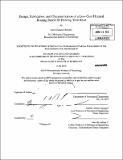Design, fabrication, and characterization of a low-cost flexural bearing based 3D printing tool head
Author(s)
Ramirez, Aaron Eduardo
DownloadFull printable version (13.85Mb)
Alternative title
Low-cost flexural bearing based 3D printing tool head
Other Contributors
Massachusetts Institute of Technology. Dept. of Mechanical Engineering.
Advisor
Martin Luther Culpepper.
Terms of use
Metadata
Show full item recordAbstract
This thesis discusses the design, characterization and optimization of a low-cost additive rapid-prototyping tool head for a technology known as Fused Filament Fabrication for use in an educational curriculum. Building a 3D printer represents an excellent educational opportunity as it requires knowledge in electronics, mechanics, and thermal-fluids engineering; this particular design also includes a flexural bearing, introducing students to a new and important class of machine element. Polymer flow through the extruder is modeled as pipe flow with pressure drops using Bernoulli's equation with viscous losses; the model predicts that the pressure required to extrude is proportional to 1/d⁴' , where d is the nozzle diameter. Three different extruder designs are considered; a piston-based design, an auger-based design, and a pinch-wheel design. The pinch wheel design best meets the functional requirements after comparing the designs based on factors such as complexity and controllability. Flexural bearings are selected to provide a preload against the polymer filament; HDPE was chosen to be the flexure material after considering factors such as water-jet machinability and yield stress to elastic modulus ratio. Thermal imaging shows that the temperature profile along the heater barrel is not uniform, with the largest variation being 80±2.8°C in large part due to errors in heater wire distribution during assembly. An exponential relationship is observed between the force required to extrude versus the temperature of the heater barrel with the force required to extrude dropping to between 1 and 2N in the range of 200 to 240°C. This data suggests trade-offs between maintaining a reasonable extruding pressure and maintaining good build resolution and speed. A discussion of the low cost rapid prototyping cycle follows, as well as instructions for assembly and use of the extruder. The paper ends with several suggestions to improve extruder performance and a list of ideas for bringing the extruder costs down.
Description
Thesis (S.B.)--Massachusetts Institute of Technology, Dept. of Mechanical Engineering, 2010. Cataloged from PDF version of thesis. Includes bibliographical references (p. 67).
Date issued
2010Department
Massachusetts Institute of Technology. Department of Mechanical EngineeringPublisher
Massachusetts Institute of Technology
Keywords
Mechanical Engineering.